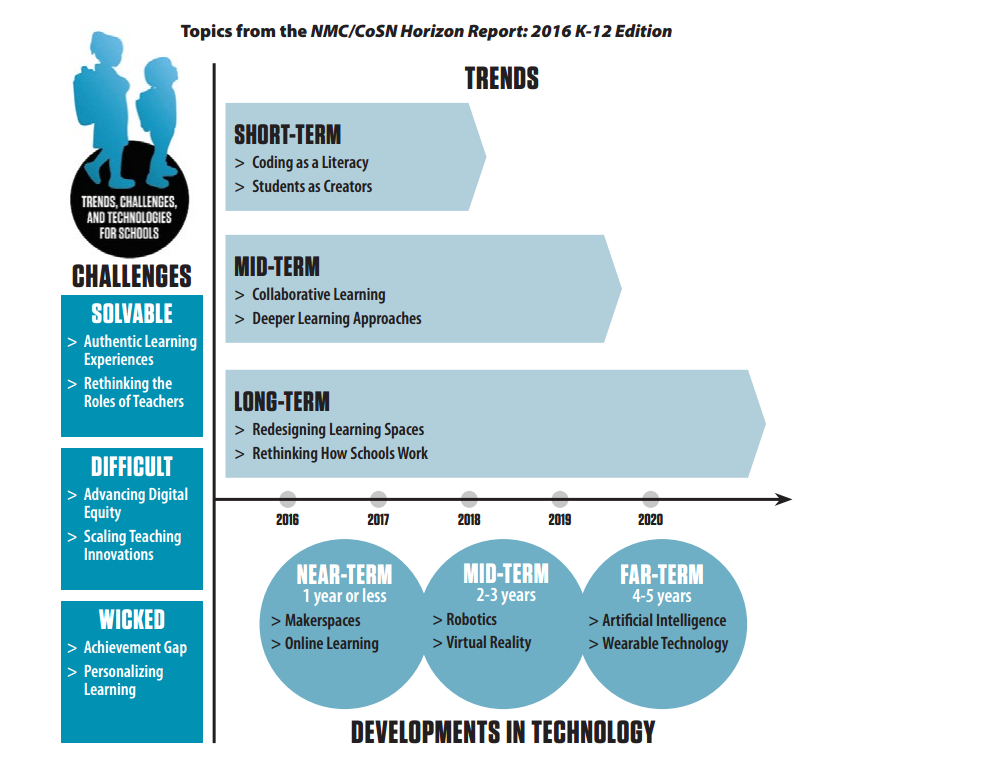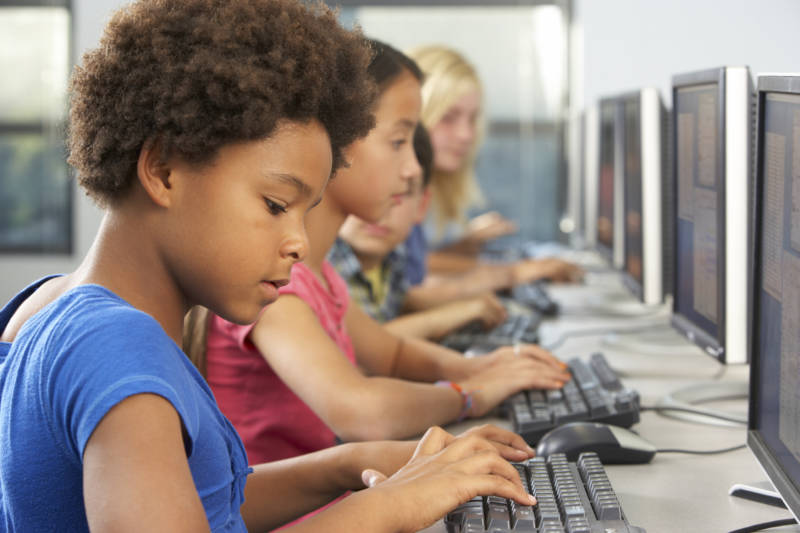Collaborative Learning: In the next three to five years, experts see collaborative social learning as an important factor in what educators are trying to do with students. Teachers have long known learning is a social process -- when students create meaning together, often the results are much more effective. The NMC/CoSN Horizon report highlights four principles of collaborative learning: “placing the learner at the center, emphasizing interaction, working in groups, and developing solutions to real-world problems.” Working in this way necessarily pushes students to create solutions, rather than passively consume content, lectures and lessons handed out by teachers.
Deeper Learning: Last year the expert panel identified deeper learning as a long-term trend, but this year is has moved to the medium term. The report focuses on how deeper learning can once again deepen student engagement with ideas and problem-solving: “Pedagogical approaches that shift the dynamic from passive to active learning allow students to develop ideas themselves from new information and take control of how they engage with a subject.”
Coding as Literacy and Students as Creators: Over the next one to two years, experts on the panel expect that more schools will accept coding as a new kind of literacy. While this will drive the adoption of technology, it also requires explicit planning for equity. Similarly, educators are recognizing that the most powerful uses of technology in the classroom position students as creators of content, not passive consumers. However, a problem remains in equity of use, where schools serving socioeconomically disadvantaged kids are given fewer opportunities to create with technology.
CHALLENGES
As with any changing industry, there are many problems standing in the way of effective technology implementation. Some problems are already being solved in creative ways by educators setting an example of the way forward, while others are more difficult and haven’t yet been solved.
Authentic Learning Experiences: One challenge that persists in mainstream education, although it is one the panelists say is well understood and can be solved, is how to create truly authentic learning opportunities within the bureaucracy of schools. As with other education buzzwords, many schools believe they are providing authentic learning, but they don’t offer the apprenticeships, vocational training and relationships with outside experts that often characterize work that carries larger life lessons.
Rethinking the Role of Teachers: The other challenge identified as a lower-bar challenge is how the role of the teacher will change. Just as the expectations of students are shifting from memorizing content to what they can do with information, so teachers must shift to create environments conducive to that type of work. This evolving expectation requires teachers to engage in their own professional development in different ways, pushing them to be active learners, too.
Advancing Digital Equity and Scaling Innovation: Equal access to high-speed internet at home and at school remains a problem that educators can easily identify, but for which solutions are elusive. As more learning moves into digital spaces, this access gap has the potential to deepen the achievement and opportunity gaps, rather than close them. Scaling promising innovations is another problem that most educators run up against, but don’t know how to get around. The report notes, “Success in teaching is closely tied to test results, and teachers are not frequently rewarded for innovative approaches and improvements in teaching and learning, much less allowed to scale and replicate these breakthroughs.” This environment of stagnation frustrates many teachers and prevents good ideas from spreading.
Achievement Gap and Personalized Learning: These are two issues that the 2016 Horizon Report identifies as thorny challenges -- those that are “complex to define, let alone address.” The achievement gap between students from different socioeconomic backgrounds and experiences has long existed, but it is promising that this report has finally identified it as a major challenge in technology implementation. Similarly, while the term “personalized learning” has been used among educators for a long time, its presence in this report as a “thorny challenge” indicates that merely adapting the pace of a student’s learning with software doesn’t achieve the full potential of what it means to make learning personal.
DEVELOPMENTS IN ED TECH
Makerspaces/Online Learning: In just one or two years, experts predict makerspaces and online learning will be common in schools. Makerspaces have emerged as one way to pack many of the trends identified above into one experience; students can identify problems, design solutions, problem solve and learn in hands-on ways in these spaces. Online learning, on the other hand, has been around for decades, but the panel notes that adoption of online learning components in brick-and-mortar classrooms has increased. Teachers are becoming more comfortable with this idea of “blending learning.”
Robotics and Virtual Reality: While the panel still agrees these technologies are two to three years from widespread adoption in K-12 learning spaces, experts predict more schools will be teaching with robots and asking students to design and build them as part of science, technology, engineering and math (STEM) courses. Virtual Reality, on the other hand, is just entering the K-12 space, but is garnering a lot of excitement. Educators see VR as a way to give students experiences that could promote empathy and expand access to novel locations.
Artificial Intelligence and Wearables: On the four- to five-year horizon, experts see artificial intelligence and wearable technology making more of an impact on K-12 schools. Included in the report as a bit of a “wow factor,” the panel sees huge potential in these technologies to inspire creativity in kids and educators. While it isn’t making a big impact yet, the report notes that as AI improves it could dramatically improve online learning experiences, adaptive technology and digital simulations.
While by no means comprehensive, the NMC/CoSN Horizon Report: K-12 Edition offers a snapshot of the ed-tech industry as the larger picture into which they fit. Sometimes technologies on earlier versions of this list have gained a lot of attention and then receded from view in subsequent years, like Massive Open Online Courses (MOOCs) or game-based learning. Others gradually move from a projection into the 20 percent adoption rate that’s considered mainstream by the report.



